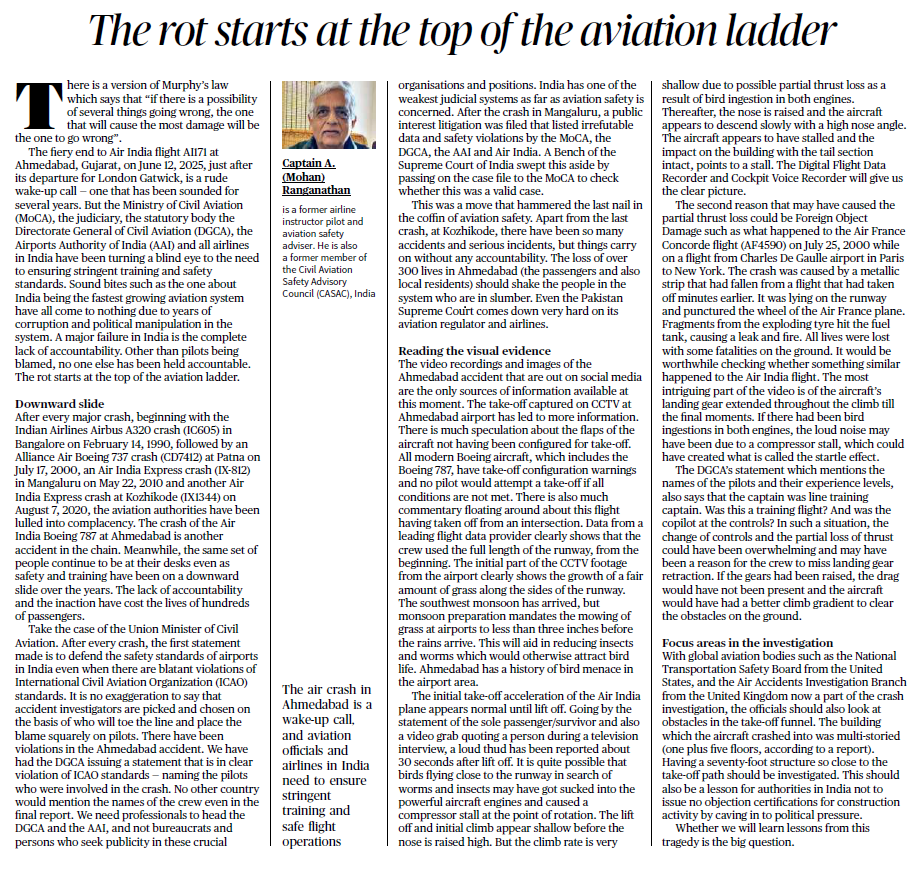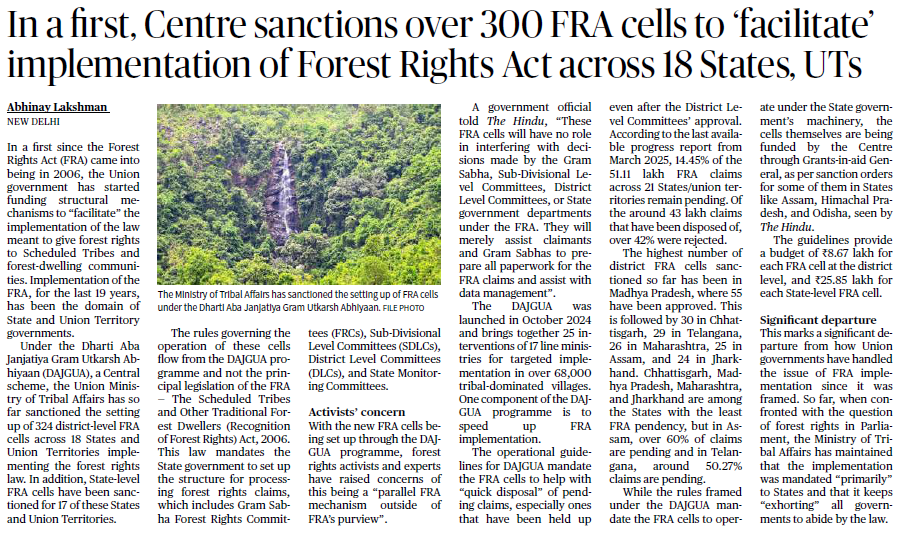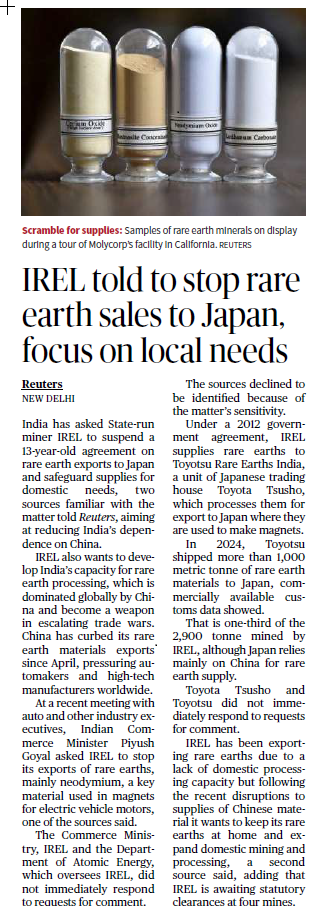
Source: The hindu
Relevant to: Governance
Why in News
- The crash of Air India flight AI187 at Ahmedabad airport on June 2, 2025, shortly after takeoff to London Gatwick, has reignited concerns about aviation safety standards in India.
- The incident is being seen as a wake-up call for India’s aviation sector, pointing to a deeper rot within the institutions responsible for regulation, accountability, and safety enforcement.
Historical Pattern of Crashes
- Past crashes (e.g., Indian Airlines A320 in 1990, Alliance Air in 2000, Mangalore in 2010, Kozhikode in 2020) reflect a pattern of negligence and weak enforcement of safety standards.
Institutional Complacency
- Statements issued by MoCA and DGCA often defend infrastructure without acknowledging ICAO violations.
- Investigators are allegedly hand-picked and investigations lack independence.
Data Disregard
- Visual and flight data (e.g., CCTV footage, FDR, CVR) often not adequately used or disclosed.
- In the Ahmedabad case, video clearly shows the aircraft scraping runway edges, suggesting poor alignment or lift-off issues.
Technical Anomalies Ignored
- Past international crashes (e.g., Air France Concorde 2000) had clear technical causes.
- In India, bird ingestion or vague reasons are cited without thorough root cause analysis.
Concerns Raised
- Lack of professional leadership in DGCA and MoCA – posts filled politically, not based on expertise.
- Failure to act on safety audits or acknowledge known risks.
- India’s weak judicial system fails to ensure accountability (even Pakistani courts are shown to have better record in aviation cases).
- System allows cover-ups and resists structural reforms.
- Accidents result in loss of experienced crew and passengers, yet no major shift in policy occurs.
Suggestions & Way Forward
- Independent Investigation Body:
- Establish an independent air crash investigation authority, similar to NTSB (USA) or AAIB (UK).
- Transparency in Reporting:
- Make crash reports, including FDR & CVR findings, public and transparent.
- Professionals in Leadership:
- Appoint experienced aviation experts, not bureaucrats or generalists, to top roles in DGCA/MoCA.
- Strict ICAO Compliance:
- Ensure strict adherence to international safety protocols and routine audit publication.
- Airfield Infrastructure Audit:
- Conduct thorough checks on runway geometry, light markers, and obstacle clearance zones.
- Pilot & ATC Training:
- Improve training for emergency scenarios, cockpit decision-making, and crisis communication.
India, despite being one of the fastest-growing aviation markets, has seen a series of major air crashes over the years with repeated systemic failures.
This tragedy has raised questions about:
- The effectiveness of DGCA, Airports Authority of India (AAI), and Ministry of Civil Aviation (MoCA).
- Accountability deficits and lack of transparency in crash investigations.
- Poor compliance with International Civil Aviation Organization (ICAO) norms.
MCQ:
Consider the following bodies:
- Directorate General of Civil Aviation (DGCA)
- Airports Authority of India (AAI)
- Ministry of Civil Aviation (MoCA)
- Indian Air Safety Investigation Board (IASIB)
Which of the above is/are responsible for ensuring aviation safety in India?
A. 1, 2 and 3 only
B. 1 and 2 only
C. 1, 3 and 4 only
D. All of the above
Answer: D
Explanation: IASIB is a wing under DGCA tasked with probing accidents. All play a role in aviation safety.

Source: The hindu
Relevant to: IR (International Relations)
Why in News
- Israel launched strikes on Iran’s nuclear facilities, notably the Natanz nuclear enrichment center, amidst ongoing U.S.-Iran diplomatic talks, escalating tensions in West Asia (Middle East).
- The attacks have increased fears of a broader regional conflict, with spillover potential into Syria, Lebanon, and even the Gulf region, threatening global oil markets and India’s interests.
- Israel has repeatedly targeted Iran’s nuclear and military infrastructure.
- Iran responded with a drone attack, while vowing further retaliation.
- Israel’s actions risk derailing any diplomatic resolution to Iran’s nuclear issue and have internationalized the conflict.
Escalation of Military Hostilities
- Israel’s attack on Natanz and missile factories, as well as Iran’s military command, marks a deliberate provocation.
- Iran’s Supreme Leader vowed a response, with threats of missile retaliation.
Iran’s Nuclear Program
- Iran has enriched uranium to 60% purity, short of weapons-grade but alarming.
- No conclusive proof yet that Iran is pursuing a nuclear weapon, but trust deficit remains.
Collapse of Diplomatic Channels
- The 2015 Iran Nuclear Deal (JCPOA) was derailed by the Trump administration, which led to Iran resuming enrichment.
- Current Israeli actions undermine any potential diplomatic engagement under Biden’s presidency.
Broader Geopolitical Implications
- Israel’s actions risk drawing in Lebanon (Hezbollah), Syria, and potentially U.S. military assets, leading to a wider war.
- India’s energy security and expatriate workforce could be severely affected if the Gulf destabilizes.
India’s Stakes
- Energy Imports: Over 60% of India’s oil comes from the Gulf.
- Diaspora: Millions of Indian workers reside in West Asia.
- Trade: Disruptions would affect bilateral trade, shipping routes, and global prices.
Way Forward
- Revive Diplomacy:
- Urgent need to resurrect JCPOA or a similar framework under international oversight.
- Role of Global Powers:
- U.S., EU, Russia, and China must act as mediators, not military backers.
- De-escalation Channels:
- Backchannel diplomacy between Iran, Israel, and Gulf states needed.
- India’s Role:
- Should push for non-alignment, stability, and diplomatic restraint via multilateral forums like UN, SCO, and NAM.
MCQ:
The Joint Comprehensive Plan of Action (JCPOA) is related to:
A. Israel-Palestine peace process
B. Syria’s chemical weapons disarmament
C. Iran’s nuclear development program
D. Saudi Arabia’s Vision 2030 reforms
Answer: C
Explanation: JCPOA was signed in 2015 between Iran and P5+1 to limit Iran’s nuclear activities in return for sanctions relief.

Source: The Hindu
Relevant to: Governance
Why in News
- India abstained from a UN General Assembly resolution (June 2025) calling for an immediate ceasefire in Gaza, where over 55,000 people have died due to Israeli military actions.
- This marks India’s fourth abstention in three years and a notable shift from its earlier vote in favor of a ceasefire resolution in December 2024.
Context & Background
- The UNGA resolution, led by Spain and co-sponsored by over 80 nations, called for:
- Ceasefire
- Unhindered humanitarian aid
- Compliance with international law by both Israel and Hamas
- India had previously supported such resolutions, indicating a policy shift toward a more cautious, strategic neutrality.
- The UNGA resolution, led by Spain and co-sponsored by over 80 nations, called for:
Reasons Behind India’s Abstention
- Consistency with Previous Abstentions:
- India abstained from UNGA resolutions on Gaza in 2021, 2022, and 2023, citing “balanced and neutral” approaches.
- Diplomatic Balancing Act:
- India seeks to maintain strong ties with Israel, especially in defense and tech.
- Simultaneously, it has traditional support for the Palestinian cause.
- External Pressure:
- Reports suggest U.S. pressure may have influenced India’s choice.
- India is among 147 nations that recognize Palestine (since 1988).
Implications for India
- Diplomatic Tightrope:
- India must carefully balance between strategic interests with Israel and its historic support for Palestine.
- Global Perception:
- Abstention could be seen as hedging or diplomatic ambiguity.
- Raises questions on India’s credibility as a voice for the Global South.
- Humanitarian Concerns vs. Realpolitik:
- The abstention comes despite UN reports of malnutrition, starvation, and death in Gaza.
- Diplomatic Tightrope:
MCQ:
India’s position on the 2025 UNGA resolution for a Gaza ceasefire can be best described as:
A. Voted in favor of the resolution
B. Opposed the resolution citing national interest
C. Abstained from voting on the resolution
D. Sponsored the resolution along with France and Spain
Answer: C

Source: The Hindu
Relevant to: Environment
Why in News
- For the first time since 2006, the Central Government has sanctioned and funded the creation of 324 Forest Rights Act (FRA) cells across 18 States and Union Territories.
- This initiative, under the Dharti Aba Janjatiya Gram Utkarsh Abhiyan (DAJUGA), marks a structural and financial intervention by the Centre to facilitate forest rights for Scheduled Tribes and Other Traditional Forest Dwellers (OTFDs).
- The Forest Rights Act, 2006 seeks to recognize and vest forest rights in forest-dwelling tribal communities.
- Till now, implementation responsibility rested primarily with States.
- Slow progress and bureaucratic hurdles have plagued the implementation.
- Of the 51.11 lakh claims filed, 28 lakh cases are still pending.
- Only 42% of claims have been disposed of.
Key Features of the Move
- Establishment of FRA Cells:
- 324 district-level and State-level FRA Cells sanctioned.
- Objective: Support claimants, streamline procedures, and aid with data and documentation.
- These cells will assist but not interfere with statutory decision-making bodies like Gram Sabhas or DLCs.
- Budgetary Support:
- ₹8.67 lakh for each district-level FRA cell.
- ₹25.85 lakh for each State-level FRA cell.
- High-Focus States:
- Madhya Pradesh leads with 55 sanctioned cells.
- Others: Chhattisgarh, Telangana, Odisha, Jharkhand, Maharashtra, Assam.
- Implementation Gap:
- Example: In Assam, over 60% of FRA claims were rejected without due legal basis.
Concerns & Criticism
- Activists’ Concerns:
- Fear of the FRA cells being used to create a parallel structure outside FRA’s legal framework.
- Suspicion of central overreach in a domain primarily under state control.
- Accountability Gap:
- Questions about whether these cells will ensure actual community empowerment or just expedite administrative targets.
- Activists’ Concerns:
Way Forward
- Ensure Role Clarity:
- FRA cells must play a facilitative, not controlling, role.
- Capacity Building:
- Train FRA cell staff, especially in tribal rights, customary law, and forest governance.
- Decentralized Decision-Making:
- Strengthen Gram Sabhas, Forest Rights Committees, and avoid centralised bureaucracy.
- Transparency & Monitoring:
- Regular public reporting of FRA progress and disposal rates.
- Use of digital platforms for tracking claims.
MCQ:
With reference to the recent establishment of FRA cells by the Central Government, consider the following statements:
- The FRA cells will function as decision-making bodies for approving individual forest rights claims.
- These FRA cells have been established under the Dharti Aba Janjatiya Gram Utkarsh Abhiyan (DAJUGA).
- The Forest Rights Act, 2006 recognizes the rights of only Scheduled Tribes over forest land.
- FRA implementation has so far been primarily the responsibility of State Governments.
Which of the statements given above are correct?
A. 2 and 4 only
B. 1 and 3 only
C. 1, 2, and 3 only
D. 2, 3, and 4 only
Answer: A. 2 and 4 only
Explanation:
- Statement 1 – Incorrect: FRA cells are not decision-making bodies; they are facilitative mechanisms to help with paperwork, awareness, and support. Decision-making rests with Gram Sabhas and other statutory bodies like DLCs and SDLCs.
- Statement 2 – Correct: The cells have been launched under the Dharti Aba Janjatiya Gram Utkarsh Abhiyan (DAJUGA).
- Statement 3 – Incorrect: The FRA, 2006 recognizes the rights of both Scheduled Tribes and Other Traditional Forest Dwellers (OTFDs).
- Statement 4 – Correct: Till now, implementation responsibility of FRA has primarily rested with State Governments.

Source: The Hindu
Relevant to: International relation
Why in News
- The ongoing Israel-Iran conflict has led to an 8% spike in global crude oil prices in a single day.
- India, which imports nearly 80% of its crude oil, faces significant risks in the form of:
- Curtailed supply of oil
- Escalated import and export costs
- Geopolitical risks in West Asia – a key source of India’s energy needs.
Energy Security Risks
- Strategic chokepoints like the Strait of Hormuz, through which ~20% of global oil passes, are vulnerable.
- Any military disruption or naval blockade here could severely affect India’s crude oil supplies.
Spike in Export Costs
- Disruptions in the Suez Canal and Red Sea routes will result in Indian exporters:
- Paying 15–20 additional days for shipping via the Cape of Good Hope.
- Facing a $500–1,000 per container hike, translating to a 40–50% cost rise.
- Disruptions in the Suez Canal and Red Sea routes will result in Indian exporters:
Inflation & Domestic Economic Pressures
- Oil is a key input in transport, logistics, and industrial sectors.
- Higher oil prices may:
- Push retail inflation higher.
- Hurt household budgets, business costs, and India’s trade balance.
- Could also impact interest rate decisions by the RBI to curb inflation.
Strategic Insights
- India’s crude oil imports are largely from:
- Iraq, Saudi Arabia, UAE, and Kuwait.
- Even if Iran is not a direct source currently, regional instability threatens supply chains and freight logistics.
- India’s energy security is inextricably linked to stability in the Gulf and West Asia.
- India’s crude oil imports are largely from:
Way Forward
- Diversification of Energy Sources:
- Expand ties with Russia, USA, Latin America, and Africa.
- Increase strategic petroleum reserves (SPR).
- Investment in Renewable Energy:
- Accelerate shift to solar, wind, and hydrogen.
- Diplomatic Balancing:
- Maintain neutrality and engage in back-channel diplomacy in West Asia.
- Boost Indigenous Production:
- Encourage domestic oil exploration and energy efficiency measures.
MCQ:
Consider the following statements regarding the impact of the Israel-Iran conflict on India:
- Over 80% of India’s crude oil requirements are met through domestic production.
- The Strait of Hormuz is a key transit route for global oil trade and its disruption could affect India’s oil imports.
- Escalation in the region may lead to increased shipping costs and delays for Indian exports.
Which of the statements given above is/are correct?
A. 1 and 2 only
B. 2 and 3 only
C. 1 and 3 only
D. 1, 2 and 3
Answer: B. 2 and 3 only
Explanation:
- Statement 1 is incorrect: India imports over 80% of its crude oil; domestic production is not the major source.
- Statement 2 is correct: The Strait of Hormuz is a crucial oil transit chokepoint; any disruption can hit India’s supplies.
- Statement 3 is correct: Export costs may rise due to re-routing via the Cape of Good Hope, increasing both costs and transit time.

Source: The Hindu
Relevant to: Economy, International Trade
Why in News: India has instructed state-run IREL (Indian Rare Earths Limited) to suspend its 13-year-old rare earth export agreement with Japan. The objective is to prioritize domestic demand and reduce dependence on
Chinese imports by boosting India’s own processing and manufacturing capabilities.
- Strategic Importance of Rare Earth Elements (REEs): Used in high-tech sectors: electronics, renewable energy, defense, electric vehicles. Critical for manufacturing permanent magnets used in wind turbines, EVs, and missiles.
- Geopolitical Angle: China dominates over 80% of global rare earth processing. Rare earths are increasingly seen as a strategic weapon in trade wars, especially amidst US-China tensions.
- India’s Dependence & Security Concerns: India has rare earth resources but lacks large-scale processing facilities. Exporting raw material while importing processed products leads to value loss.
- Policy Shift: India is now emphasizing “Atmanirbhar Bharat” in critical sectors. Government aims to develop domestic processing capacity and value chains for rare earths.
- International Trade Dynamics: Japan, a major rare earth importer, is affected as it seeks to diversify away from Chinese supplies. India’s decision may impact global rare earth supply chains.
- Institutional Role: Decision involves IREL, Department of Atomic Energy, Ministry of Commerce. Reflects inter-ministerial coordination in strategic economic decisions.
MCQ:
With reference to Rare Earth Elements (REEs), consider the following statements:
- Rare earth elements are essential for the production of permanent magnets used in electric vehicles and wind turbines.
- India is a leading exporter of processed rare earth elements globally.
- China dominates the global rare earth processing industry. Which of the above statements is/are correct?
A) 1 and 2 only
B) 2 and 3 only
C) 1 and 3 only
D) 1, 2 and 3
Correct Answer: C) 1 and 3 only
Explanation:
Statement 1 is correct: Permanent magnets, vital for EVs and turbines, require REEs like neodymium.
Statement 2 is incorrect: India mainly exports raw rare earths; it lacks significant processing capacity.
Statement 3 is correct: China controls over 80% of the rare earth processing market.

Source: The Hindu
Topic: Sports | Women Empowerment | Youth in Sports | International Relations (Soft Power)
Why in News
- Suruchi Phogat, a 19-year-old Indian shooter, clinched her third consecutive gold medal in the women’s 10m air pistol event at the ISSF Shooting World Cup 2025 in Munich, Germany.
Facts
- Age: 19 years
- Event: Women’s 10m Air Pistol
- Tournament: ISSF World Cup 2025
- Location: Munich, Germany
- Achievement: 3rd consecutive gold medal in World Cup events
Mains Relevance & Analysis
- Emergence of Young Sporting Talent in India
- Suruchi Phogat exemplifies how youth from India are excelling globally in sports.
- Shows increasing grassroots participation and elite-level success due to better exposure and coaching.
- Women Empowerment through Sports
- Marks growing female representation in elite sports.
- Reflects success of gender-inclusive policies in sports like Khelo India and special women’s coaching initiatives.
- India’s Rising Profile in Olympic Disciplines
- Shooting is one of India’s best-performing Olympic sports.
- Athletes like Abhinav Bindra, Gagan Narang, and now Suruchi Phogat highlight consistent international performances.
- Soft Power and Global Image
- Sporting victories act as soft power tools, enhancing India’s image as a rising power.
- Aligns with India’s foreign policy goal of increasing cultural and diplomatic influence.
- Government Schemes Supporting Athletes
- Khelo India, Target Olympic Podium Scheme (TOPS) have been critical in grooming elite shooters.
- Institutional support has improved sports science, psychological training, and international exposure.
Relevant Schemes and Bodies
- Khelo India Scheme
- Target Olympic Podium Scheme (TOPS)
- Sports Authority of India (SAI)
- ISSF – International Shooting Sport Federation
MCQ:
With reference to India’s performance in international shooting events, consider the following statements:
- Suruchi Phogat recently won her third consecutive World Cup gold medal in the women’s 10m air pistol event.
- The International Shooting Sport Federation (ISSF) conducts the Shooting World Cup.
- India has never won an Olympic medal in shooting.
Which of the above statements is/are correct?
A) 1 and 2 only
B) 2 and 3 only
C) 1 and 3 only
D) 1, 2 and 3
Correct Answer: A) 1 and 2 only
Explanation:
- Statement 1 is correct: Suruchi Phogat won her third consecutive World Cup gold.
- Statement 2 is correct: ISSF conducts the Shooting World Cup.
- Statement 3 is incorrect: India has multiple Olympic shooting medals (e.g., Abhinav Bindra – 2008 Gold).
